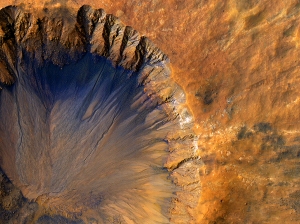The i in the name of the iMars project could easily stand for ‘inter-disciplinary’ and I am enjoying learning about the science behind the project as well as the part of the project for which I am responsible. My thesis was full of acronyms from the NHS (sorry, National Health Service) and now I am learning the language of imagery and planetary science. iMars largely exploits images taken by three cameras that circle Mars. To aid my own understanding I will now attempt to describe these cameras and how the iMars team are using their images.*
Contestant 1: High Resolution Imaging Science Equipment (HiRISE)
Launched in August 2005, on NASA’s Mars Reconnaissance Orbiter (MRO) spacecraft, HiRISE‘s 50 cm aperture reflecting telescope enables it to take pictures in the visible wavelength with 25 to 60 cm/pixel resolutions, and thus capture features on the surface of Mars that are smaller than a metre across. Not bad from 200-400 kilometres (km) above the planet! HiRISE reimages locations of special interest with different spacecraft rolls (to the left or right of the groundtrack) to acquire stereo pairs or 3D views of the surface that are typically 5-6 km wide. Since it is still in orbit, you can see the images it captures, and DTMs created with the images, online. To date HiRISE has acquired 960 stereo pairs of images to create over 50 digital terrain models (DTMs) of the Martian surface.
Contestant 2: Context (CTX)
The CTX camera, also on the MRO, takes images to complement the high-resolution images collected by HiRISE and mineral data collected by MRO‘s Compact Reconnaissance Imaging Spectrometer for Mars (CRISM). From 400 kilometres above Mars, CTX has imaged terrain of 30 kilometres across at a resolution of six metres per pixel for over 50% of the planet. Whilst not matching the detail of HiRISE images, CTX images can still be used to study aeolian features with a better field of view, as beautifully illustrated here.
Contestant 3: High Resolution Stereo Camera (HRSC)
Finally, iMars exploits images taken by the European Space Agency’s HRSC, on board the Mars Express Orbiter that launched in 2003 along with the fabled and failed Beagle 2 Lander. Its online documentation is comprehensive, so I will be brief here.
The camera comprises of two parts: 1) the Camera Head, contains nine lines of light-sensitive cells perpendicular to the flight path that acquire nine strips of ten metres per pixel images for each operation of variable frequency (including three channels in stereo for the creation of DTMs), and 2) the Super Resolution Channel, which takes pictures of 1024 X 1032 (2.3 metre) pixel areas, each corresponding to a 2.35 km square on the Martian surface from its altitude of 250 km.
Co-registration: the Best of All Three
Now, just for a moment, imagine that you are a detective and three witnesses have come forward to report the same crime. Each saw the scene at different times, from different distances and in different lighting; because of this, they provide different details about the crime with different levels of certainty. In this situation, a detective needs as many concrete details as they can get and the sum of all witness accounts will be more valuable than one on its own. It is the same for images taken by the three cameras I have just described. The iMars team has developed algorithms that not only match the 2D images to their location on the surface of Mars, but combine/triangulate the data from all three cameras to provide a “co-registered” image that represents the most accurate and precise information from all three. It is these co-registered images that we will display on the iMars website for visitors to mark and analyse changes in geological features on Mars.
*Credit for this post must also go to James Sprinks, who is the PhD student on the project and explained to me that the co-registered images have been created by data acquired by much older missions to Mars, but for my purposes of understanding we are most interested in the three highlighted here. You can follow James on Twitter here.
